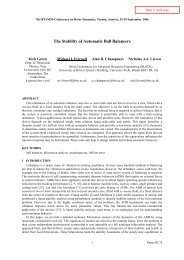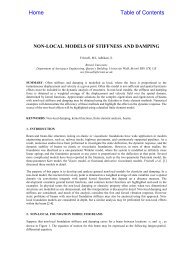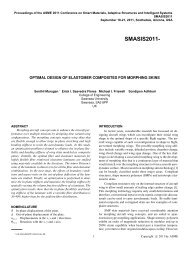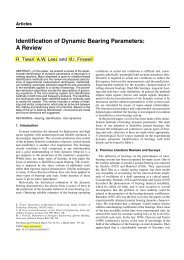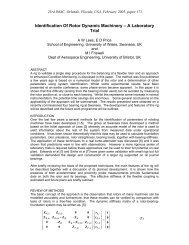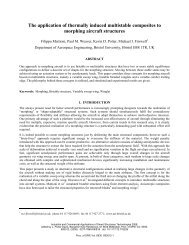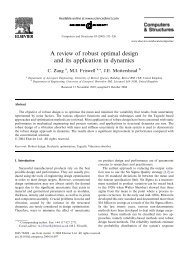M. <strong>Friswell</strong>, J. Sawicki, D. Inman, A. Leestransient forces may cause the machine to change from<strong>on</strong>e steady state soluti<strong>on</strong> to the other. <str<strong>on</strong>g>The</str<strong>on</strong>g> durati<strong>on</strong> <str<strong>on</strong>g>of</str<strong>on</strong>g>these transient forces would have to be sufficiently l<strong>on</strong>gto change the support temperature.IV.3. Transient <str<strong>on</strong>g>Resp<strong>on</strong>se</str<strong>on</strong>g>Finally, c<strong>on</strong>sider what happens when the machine isrun-up to its operating speed. Initially the machine is atthe ambient temperature, and the vibrati<strong>on</strong>s <str<strong>on</strong>g>of</str<strong>on</strong>g> themachine will cause heating <str<strong>on</strong>g>of</str<strong>on</strong>g> the elastomer supports.Fig. 12 shows an ideal resp<strong>on</strong>se at the balance plane(i.e. the right end <str<strong>on</strong>g>of</str<strong>on</strong>g> the rotor), generated by performinga run-up, while keeping the temperature <str<strong>on</strong>g>of</str<strong>on</strong>g> the supportsat the ambient temperature. <str<strong>on</strong>g>The</str<strong>on</strong>g> rotati<strong>on</strong>al speed is runuplinearly from 1000 to 30,000 rev/min over 100 s.Since the machine was balanced at a single plane at therunning speed the unbalance resp<strong>on</strong>se at low speeds islarge, but the machine becomes balanced as the speedincreases.Suppose now that the energy dissipati<strong>on</strong> part <str<strong>on</strong>g>of</str<strong>on</strong>g> themodel is included. Suitable parameters for this modelare difficult to estimate as they depend critically <strong>on</strong> thedesign <str<strong>on</strong>g>of</str<strong>on</strong>g> the supporting structure. For illustrati<strong>on</strong> the−1−4 −1parameters cV v = 001JK . and κ T = 4×10 WKhave been chosen. In numerical trials these values givesa reas<strong>on</strong>able rise in the temperature <str<strong>on</strong>g>of</str<strong>on</strong>g> the supports,although the results are very sensitive to theseparameters. Fig. 13 shows the resp<strong>on</strong>se at the right end<str<strong>on</strong>g>of</str<strong>on</strong>g> the rotor during the run-up, and highlights that themachine is not balanced. Note that the simulati<strong>on</strong> inFig. 13 is over a l<strong>on</strong>ger time period than that shown inFig. 12. Fig. 14 shows the rise in temperature and alsothe rotati<strong>on</strong>al speed <str<strong>on</strong>g>of</str<strong>on</strong>g> the machine. Although themaximum resp<strong>on</strong>se during the run-up is similar in Figs.12 and 13, the key difference is that when thetemperature is fixed the machine is perfectly balancedwhen the running speed is reached, as shown in Fig. 12.However if the elastomer temperature changes then themachine is never perfectly balanced, as shown in Fig.13.Accelerati<strong>on</strong> magnitude (m/s 2 )0.60.40.200 50 100Time (s)Fig. 12. <str<strong>on</strong>g>The</str<strong>on</strong>g> run-up resp<strong>on</strong>se at the balance plane for the machineobtained by keeping the elastomer temperature fixedAccelerati<strong>on</strong> magnitude (m/s 2 )0.60.40.200 100 200 300Time (s)Fig. 13. <str<strong>on</strong>g>The</str<strong>on</strong>g> run-up resp<strong>on</strong>se at the balance plane for the machinewhen the support temperature increasesTemperature (K)2922912900 100 200 300Time (s)0 100 200 300 0 103020Rotor speed (x1000 rev/min)Fig. 14. <str<strong>on</strong>g>The</str<strong>on</strong>g> support temperatures (solid) and the rotati<strong>on</strong>al speed(dashed) <str<strong>on</strong>g>of</str<strong>on</strong>g> the machineIf the running temperature <str<strong>on</strong>g>of</str<strong>on</strong>g> the machine could beestimated then the machine could be balanced at thistemperature. However small changes in the ambienttemperature or the support c<strong>on</strong>figurati<strong>on</strong> may causechanges in this operati<strong>on</strong>al temperature that wouldsignificantly increase the resp<strong>on</strong>se at the operati<strong>on</strong>alspeed. In fact the situati<strong>on</strong> is even more complex. <str<strong>on</strong>g>The</str<strong>on</strong>g>problem is highly n<strong>on</strong>-linear, and the temperature <str<strong>on</strong>g>of</str<strong>on</strong>g> thesupports also depends <strong>on</strong> the past history <str<strong>on</strong>g>of</str<strong>on</strong>g> vibrati<strong>on</strong>,for example how the machine was run-up, since thereare multiple steady state soluti<strong>on</strong>s. Balancing suchsystems will be very difficult.V. C<strong>on</strong>clusi<strong>on</strong>This paper has investigated the effect <str<strong>on</strong>g>of</str<strong>on</strong>g> an elastomersupport <strong>on</strong> the dynamics <str<strong>on</strong>g>of</str<strong>on</strong>g> a rotating machine. Inparticular the effect <str<strong>on</strong>g>of</str<strong>on</strong>g> the frequency and temperaturedependent modulus has been dem<strong>on</strong>strated. Althoughthe example was relatively simple a number <str<strong>on</strong>g>of</str<strong>on</strong>g>c<strong>on</strong>clusi<strong>on</strong>s may be drawn. It was shown that thedynamic characteristics <str<strong>on</strong>g>of</str<strong>on</strong>g> a machine changesignificantly with temperature because <str<strong>on</strong>g>of</str<strong>on</strong>g> the changes instiffness and damping characteristics <str<strong>on</strong>g>of</str<strong>on</strong>g> the elastomer.Copyright © 2007 Praise Worthy Prize S.r.l. - All rights reserved Internati<strong>on</strong>al Review <str<strong>on</strong>g>of</str<strong>on</strong>g> Mechanical Engineering, Vol. 1, n. 139
M. <strong>Friswell</strong>, J. Sawicki, D. Inman, A. LeesAccurate balancing <str<strong>on</strong>g>of</str<strong>on</strong>g> high speed machines <strong>on</strong>elastomer supports is difficult when the thermalenvir<strong>on</strong>ment is likely to change. Such a change mayoccur because <str<strong>on</strong>g>of</str<strong>on</strong>g> an uncertain ambient temperature ordifferent vibrati<strong>on</strong> histories causing a variati<strong>on</strong> in theenergy dissipati<strong>on</strong> and hence temperature in theelastomer.Acknowledgements<strong>Friswell</strong> acknowledges the support <str<strong>on</strong>g>of</str<strong>on</strong>g> a RoyalSociety-Wolfs<strong>on</strong> Research Merit Award.References[1] K. Bhattacharyya, J.K. Dutt, Unbalance resp<strong>on</strong>se and stabilityanalysis <str<strong>on</strong>g>of</str<strong>on</strong>g> horiz<strong>on</strong>tal rotor systems mounted <strong>on</strong> n<strong>on</strong>linearrolling element bearings with viscoelastic supports, Journal <str<strong>on</strong>g>of</str<strong>on</strong>g>Vibrati<strong>on</strong> and Acoustics, Vol. 119, No. 4, pp. 539-544, 1997.[2] K.C. Panda, J.K. Dutt, Design <str<strong>on</strong>g>of</str<strong>on</strong>g> optimum support parametersfor minimum rotor resp<strong>on</strong>se and maximum stability limit,Journal <str<strong>on</strong>g>of</str<strong>on</strong>g> Sound and Vibrati<strong>on</strong>, Vol. 223, No. 1, pp. 1-21, 1999.[3] J.K. Dutt, T. Toi, Rotor vibrati<strong>on</strong> reducti<strong>on</strong> with polymericsectors, Journal <str<strong>on</strong>g>of</str<strong>on</strong>g> Sound and Vibrati<strong>on</strong>, Vol. 262, No. 4, pp.769-793, 2003.[4] A. Bormann, R. Gasch, Damping and Stiffness Coefficients <str<strong>on</strong>g>of</str<strong>on</strong>g>Elastomer Rings and their Applicati<strong>on</strong> in Rotor Dynamics:<str<strong>on</strong>g>The</str<strong>on</strong>g>oretical Investigati<strong>on</strong>s and Experimental Validati<strong>on</strong>, Proc. <str<strong>on</strong>g>of</str<strong>on</strong>g>the Sixth IFToMM Internati<strong>on</strong>al C<strong>on</strong>ference <strong>on</strong> Rotor Dynamics,Sydney Australia, 2002.[5] S. Adhikari, Eigenrelati<strong>on</strong>s for n<strong>on</strong>viscously damped system,AIAA Journal, Vol. 39, No. 8, pp. 1624-1630, 2001.[6] S. Adhikari, J. Woodhouse, Identificati<strong>on</strong> <str<strong>on</strong>g>of</str<strong>on</strong>g> damping part 2:n<strong>on</strong>-viscous damping, Journal <str<strong>on</strong>g>of</str<strong>on</strong>g> Sound and Vibrati<strong>on</strong>, Vol. 243,No. 1, pp. 63-88, 2001.[7] J. Woodhouse, Linear damping models for structural vibrati<strong>on</strong>,Journal <str<strong>on</strong>g>of</str<strong>on</strong>g> Sound and Vibrati<strong>on</strong>, Vol. 215, No. 3, pp. 547-569,1998.[8] R.L. Bagley, P.J. Torvik, Fracti<strong>on</strong>al calculus–a differentapproach to the analysis <str<strong>on</strong>g>of</str<strong>on</strong>g> viscoelastically damped structures,AIAA Journal, Vol. 21, No. 5, pp. 741–748, 1983.[9] R.L. Bagley, P.J. Torvik, Fracti<strong>on</strong>al calculus in the transientanalysis <str<strong>on</strong>g>of</str<strong>on</strong>g> viscoelastically damped structures, AIAA Journal,Vol. 23, No. 6, pp. 918-925, 1985.[10] D.F. Golla, P.C. Hughes, Dynamics <str<strong>on</strong>g>of</str<strong>on</strong>g> viscoelastic structures - atime domain, finite element formulati<strong>on</strong>, Journal <str<strong>on</strong>g>of</str<strong>on</strong>g> AppliedMechanics, Vol. 52, pp. 897-906, 1985.[11] D.J. McTavish, P.C. Hughes, Modeling <str<strong>on</strong>g>of</str<strong>on</strong>g> linear viscoelasticspace structures, Journal <str<strong>on</strong>g>of</str<strong>on</strong>g> Vibrati<strong>on</strong> and Acoustics, Vol. 115,pp. 103-113, 1993.[12] G.A. Lesieutre, D.L. Mingori, Finite element modeling <str<strong>on</strong>g>of</str<strong>on</strong>g>frequency-dependent material properties using augmentedthermodynamic fields, AIAA Journal <str<strong>on</strong>g>of</str<strong>on</strong>g> Guidance C<strong>on</strong>trol andDynamics, Vol. 13, pp. 1040-1050, 1990.[13] G.A. Lesieutre, Finite elements for dynamic modeling <str<strong>on</strong>g>of</str<strong>on</strong>g>uniaxial rods with frequency dependent material properties,Internati<strong>on</strong>al Journal <str<strong>on</strong>g>of</str<strong>on</strong>g> Solids and Structures, Vol. 29, pp.1567-1579, 1992.[14] G.A. Lesieutre, E. Bianchini, Time domain modeling <str<strong>on</strong>g>of</str<strong>on</strong>g> linearviscoelasticity using anelastic displacement fields, ASMEJournal <str<strong>on</strong>g>of</str<strong>on</strong>g> Vibrati<strong>on</strong> and Acoustics, Vol. 117, pp. 424-430,1995.[15] G.A. Lesieutre, U. Lee, A finite element for beams havingsegmented active c<strong>on</strong>trained layers with frequency-dependentviscoelastics, Smart Materials and Structures, Vol. 5, pp. 615-627, 1996.[16] L.C. Rogers, C.D. Johns<strong>on</strong>, D.A. Keinholz, <str<strong>on</strong>g>The</str<strong>on</strong>g> modal strainenergy finite element method and its applicati<strong>on</strong> to dampedlaminated beams, <str<strong>on</strong>g>The</str<strong>on</strong>g> Shock and Vibrati<strong>on</strong> Bulletin, Vol. 51,1981.[17] D.J. Inman, Vibrati<strong>on</strong> analysis <str<strong>on</strong>g>of</str<strong>on</strong>g> viscoelastic beams byseparati<strong>on</strong> <str<strong>on</strong>g>of</str<strong>on</strong>g> variables and modal analysis, Mechanics ResearchCommunicati<strong>on</strong>s, Vol. 16, No. 4, pp. 213-218, 1989.[18] H.T. Banks, D.J. Inman, On damping mechanisms in beams,Journal <str<strong>on</strong>g>of</str<strong>on</strong>g> Applied Mechanics, Vol. 58, pp. 716-723, 1991.[19] M.I. <strong>Friswell</strong>, D.J. Inman, M.J. Lam, On the realisati<strong>on</strong> <str<strong>on</strong>g>of</str<strong>on</strong>g> GHMmodels in viscoelasticity, Journal <str<strong>on</strong>g>of</str<strong>on</strong>g> Intelligent Material Systemsand Structures, Vol. 8, No. 11, pp. 986-993. 1997.[20] G.A. Lesieutre, K. Govindswamy, Finite element modelling <str<strong>on</strong>g>of</str<strong>on</strong>g>frequency-dependent and temperature-dependent dynamicbehavior <str<strong>on</strong>g>of</str<strong>on</strong>g> viscoelastic material in simple shear, Internati<strong>on</strong>alJournal <str<strong>on</strong>g>of</str<strong>on</strong>g> Solids and Structures, Vol. 33, pp. 419-432, 1996.[21] C.R. Brackbill, G.A. Lesieutre, E.C. Smith, K. Govindswamy,<str<strong>on</strong>g>The</str<strong>on</strong>g>rmomechanical modelling <str<strong>on</strong>g>of</str<strong>on</strong>g> elastomeric materials, SmartMaterials and Structures, Vol. 5, pp. 529-539, 1996.[22] L.A. Silva, E.M. Austin, D.J. Inman, Time-varying c<strong>on</strong>troller fortemperature-dependent viscoelasticity, Journal <str<strong>on</strong>g>of</str<strong>on</strong>g> Vibrati<strong>on</strong> andAcoustics, Vol. 127, pp. 215-222, 2005.[23] C. Zang, A.W. Lees, M.I. <strong>Friswell</strong>, Multi plane balancing <str<strong>on</strong>g>of</str<strong>on</strong>g> arotating machine using a single transducer, Proc. <str<strong>on</strong>g>of</str<strong>on</strong>g> the SixthIFToMM Internati<strong>on</strong>al C<strong>on</strong>ference <strong>on</strong> Rotor Dynamics, SydneyAustralia, 2002, pp. 130-136.Authors’ informati<strong>on</strong>1 <strong>Michael</strong> I. <strong>Friswell</strong>, Department <str<strong>on</strong>g>of</str<strong>on</strong>g> Aerospace Engineering, BristolUniversity. UK2 Jerzy T. Sawicki, Department <str<strong>on</strong>g>of</str<strong>on</strong>g> Mechanical Engineering, ClevelandState University, USA.3 Daniel J. Inman, CIMSS, Virginia Tech, USA.4 Arthur W. Lees, School <str<strong>on</strong>g>of</str<strong>on</strong>g> Engineering, University <str<strong>on</strong>g>of</str<strong>on</strong>g> WalesSwansea, UK.Copyright © 2007 Praise Worthy Prize S.r.l. - All rights reserved Internati<strong>on</strong>al Review <str<strong>on</strong>g>of</str<strong>on</strong>g> Mechanical Engineering, Vol. 1, n. 140




